Welcome to Tunisia, a captivating country nestled on the Mediterranean coast of North Africa. With a rich history, diverse landscapes, and a fusion of Arab, Berber, and European influences, Tunisia offers a remarkable travel experience for all types of explorers.
In this guide, we will unveil the top 15 destinations that showcase the country's enchanting charm, from ancient ruins and bustling medinas to stunning beaches and desert oases. Get ready to embark on a journey through Tunisia's cultural tapestry and natural wonders, as we unveil the must-visit destinations that make this North African gem truly unforgettable.
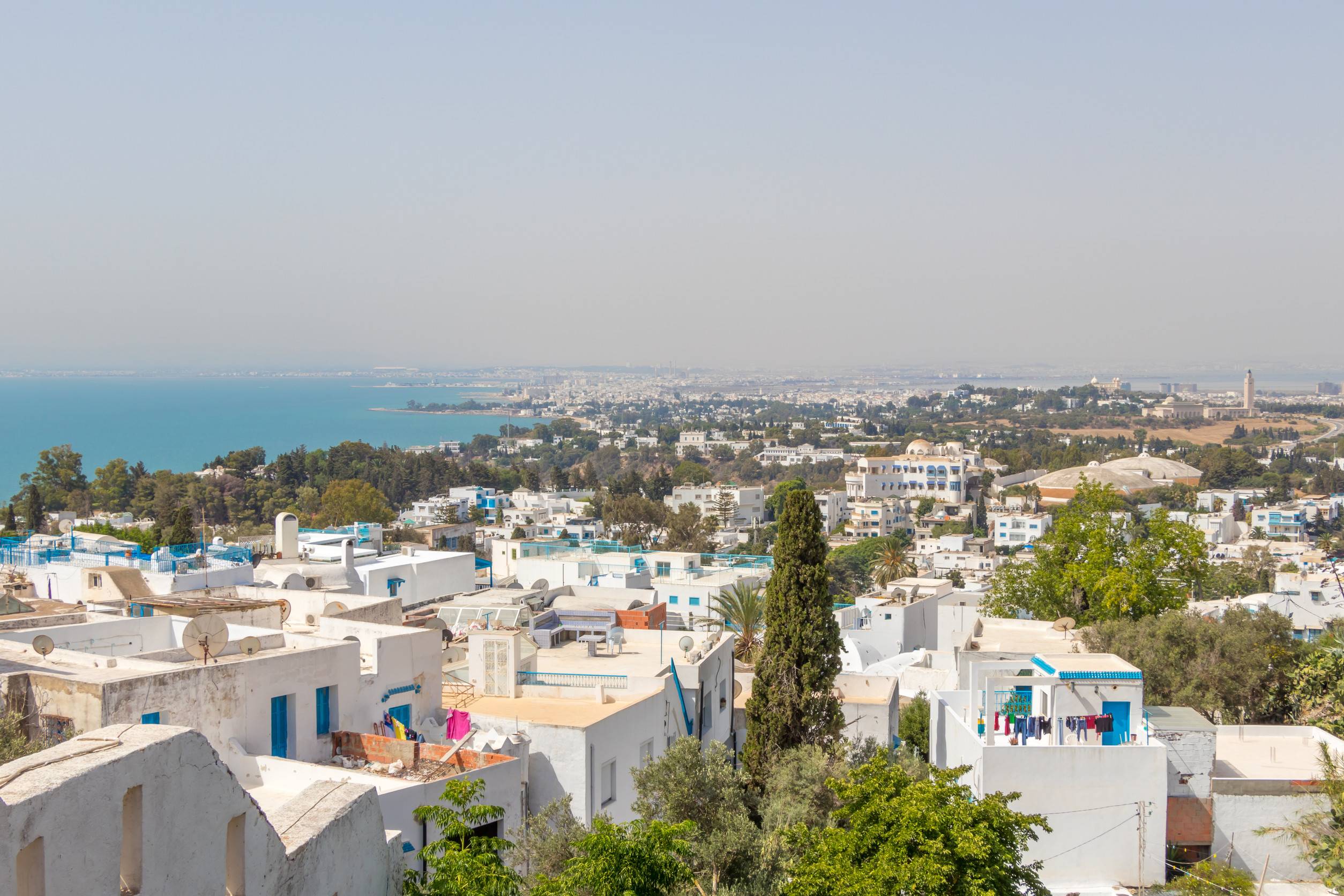
Climate: Tunis has a Mediterranean climate with hot, dry summers and mild, wet winters. The summer months (June to August) are hot, with temperatures often exceeding 30°C (86°F), while winters (December to February) are mild with temperatures ranging between 8°C and 16°C (46°F to 61°F).
History: Tunis has a rich history dating back to ancient times. It was originally founded by the Berbers and later became a prominent Phoenician trading centre. The city has witnessed the rule of various civilizations, including the Romans, Vandals, Byzantines, Arabs, and Ottomans. It played a significant role in the mediaeval Islamic world as the capital of the Fatimid Caliphate. Today, Tunis reflects this diverse historical heritage through its architecture, ancient ruins, and cultural traditions.
Culture: Tunisian culture is a blend of Arab, Berber, and Mediterranean influences. The majority of the population practises Islam, which has a strong influence on daily life, customs, and traditions. Tunisians are known for their hospitality, warmth, and vibrant celebrations. The country has a rich artistic heritage, including traditional music, dance, and handicrafts such as ceramics, carpets, and metalwork.
Attractions: Tunis offers numerous attractions for visitors to explore. The Medina of Tunis, a UNESCO World Heritage Site, is a labyrinth of narrow streets, bustling souks, and historic buildings, including the Zitouna Mosque. The Bardo Museum houses a remarkable collection of Roman mosaics and other archaeological artefacts. The Carthage archaeological site features ancient ruins, including the Roman Theater and the Antonine Baths. The picturesque village of Sidi Bou Said is known for its blue and white architecture and stunning views of the Mediterranean Sea. Other attractions include the National Museum of Tunisia, Dar Ben Abdallah Museum, and the modern business district of La Marsa.
These are just a few highlights of the climate, history, culture, and attractions of Tunisia. The city offers a captivating blend of ancient and modern, providing visitors with a unique and memorable experience.
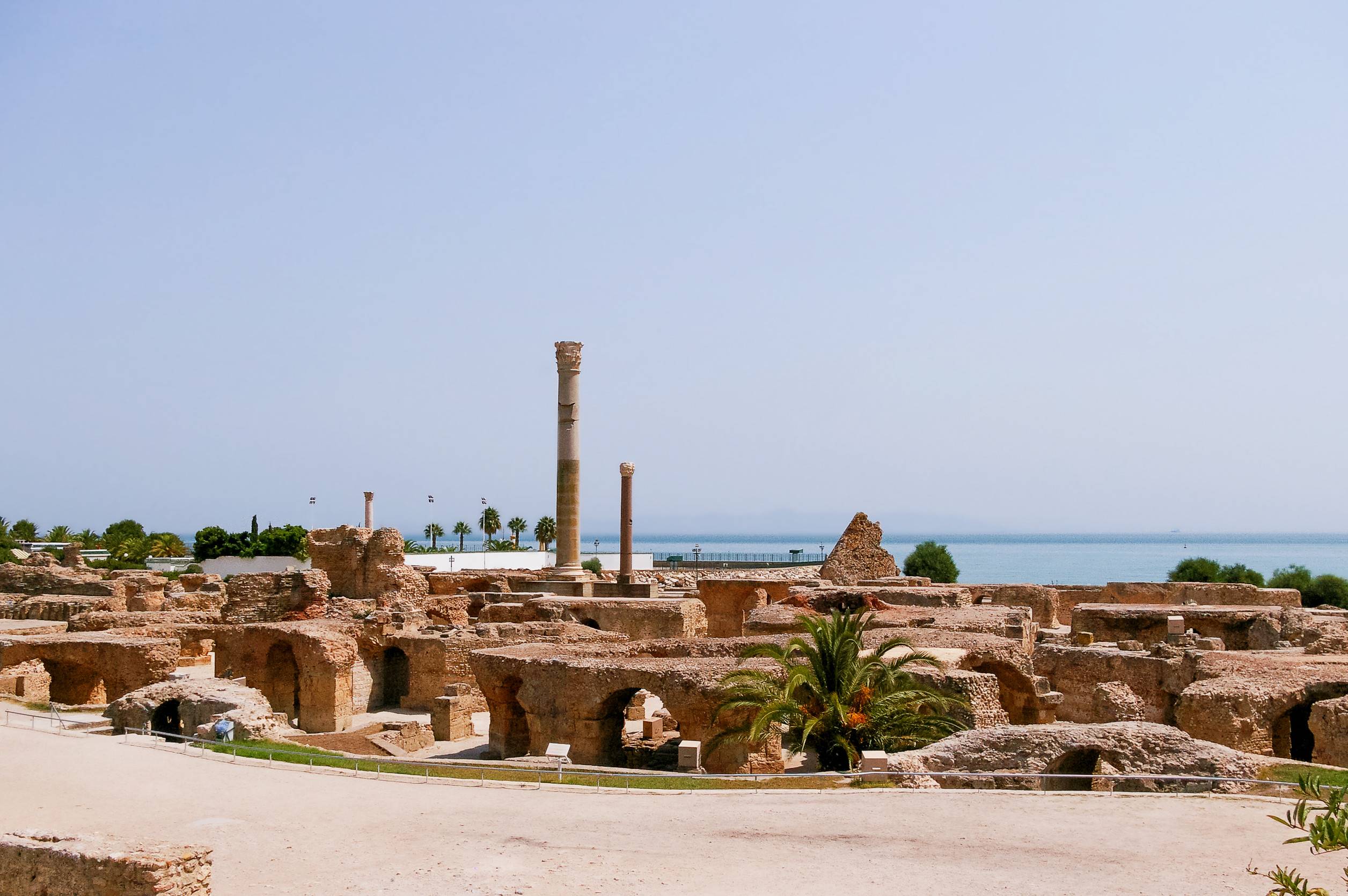
A UNESCO World Heritage Site that was once a powerful ancient city and the capital of the Carthaginian Empire.
Climate: Carthage has a Mediterranean climate similar to Tunis, with hot, dry summers and mild, wet winters. The summer months (June to August) are hot, with temperatures often reaching 30°C (86°F) or higher, while winters (December to February) are mild with temperatures ranging between 8°C and 16°C (46°F to 61°F).
History: Carthage was once a powerful ancient city and the capital of the Carthaginian Empire. Founded by the Phoenicians in the 9th century BCE, it became a major trading and maritime power in the Mediterranean. Carthage had a complex and eventful history, including wars with Rome, most notably the Punic Wars. The city was eventually destroyed by the Romans in the Third Punic War in 146 BCE. Today, Carthage is an important archaeological site showcasing the remains of the ancient city and its various periods of history.
Culture: Carthage has a rich cultural heritage influenced by its ancient past. The city is known for its historical significance and archaeological sites, which attract visitors from around the world. The Carthaginian culture, as well as subsequent Roman and Byzantine influences, have left their mark on the art, architecture, and traditions of the region.
Attractions: Carthage is primarily known for its archaeological sites, which offer a glimpse into its ancient history. The Carthage Museum showcases artifacts and exhibits related to the city's past. The Roman Theater of Carthage, with its impressive ruins and panoramic views, is a must-visit attraction. The Antonine Baths, ancient villas, and the Carthage National Museum are also worth exploring. Additionally, Carthage is located along the coast, providing visitors with beautiful views of the Mediterranean Sea.
These are some of the highlights of the climate, history, culture, and attractions of Carthage. Exploring the ancient ruins and learning about the city's fascinating past make it a compelling destination for history enthusiasts and those interested in ancient civilizations.
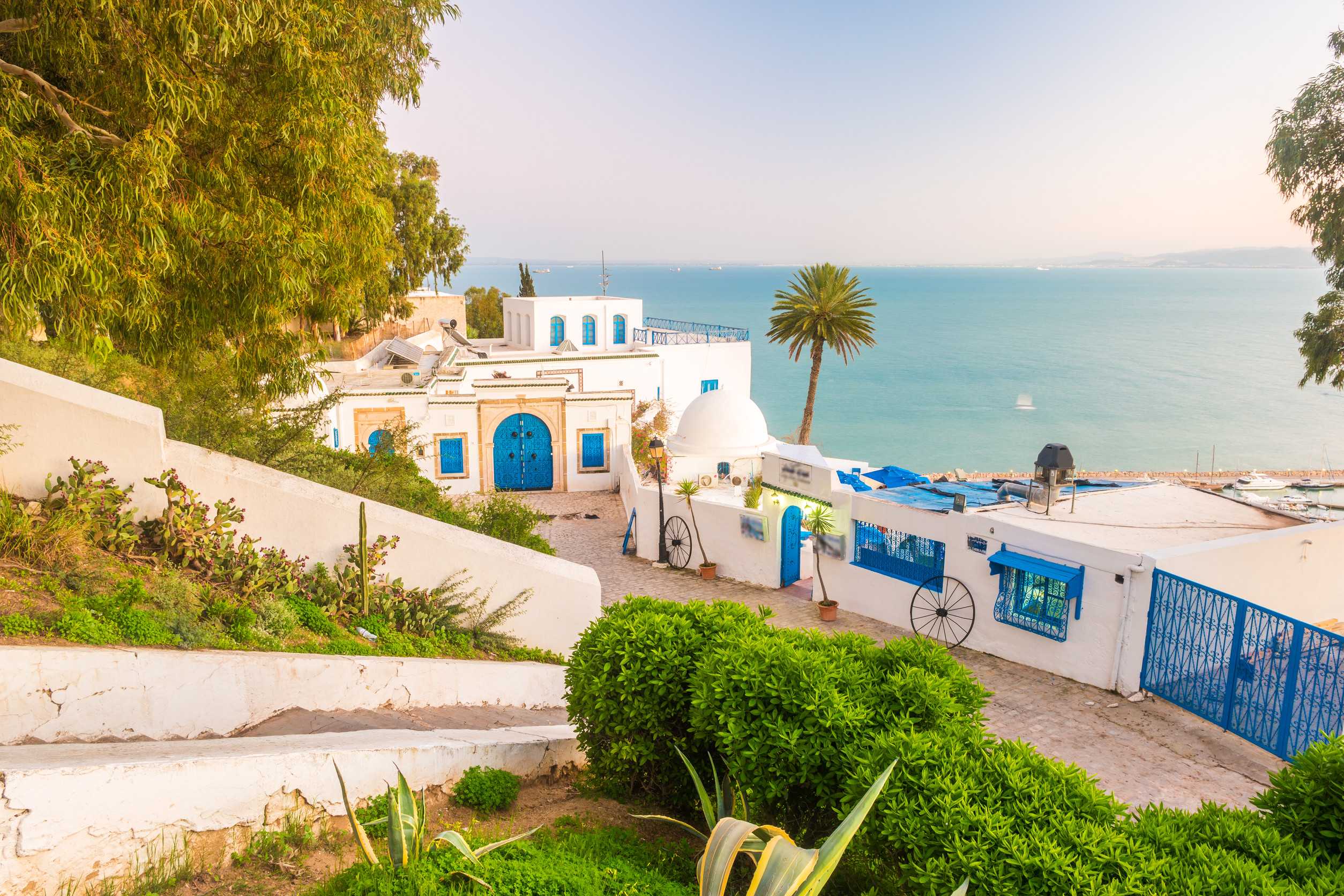
A picturesque village known for its blue and white architecture, narrow streets, and stunning views of the Mediterranean Sea. Sidi Bou Said is a charming village located just a short distance from Tunis. Known for its blue and white architecture, picturesque streets, and stunning views of the Mediterranean Sea, Sidi Bou Said is a popular destination for both locals and tourists. Here is some information about Sidi Bou Said:
Climate: Sidi Bou Said has a Mediterranean climate, similar to Tunis. Summers are hot and dry, with temperatures often reaching 30°C (86°F) or higher, while winters are mild with temperatures ranging between 8°C and 16°C (46°F to 61°F). The village experiences pleasant weather in spring and autumn, making those seasons ideal for visiting.
History: Sidi Bou Said has a rich history dating back to the 13th century. It was named after a Sufi saint, Abu Said al-Baji, who was believed to have lived in the area. Over the centuries, the village became a popular retreat for artists, writers, and musicians, who drew inspiration from its beauty and tranquillity. Today, Sidi Bou Said is recognized as a cultural and artistic hub in Tunisia.
Culture: Sidi Bou Said is known for its unique architectural style, characterised by white-washed buildings adorned with blue accents. The colour combination is believed to ward off evil spirits and create a calming atmosphere. The village exudes a bohemian vibe, with art galleries, craft shops, and cafes lining its narrow streets. Traditional music and dance performances can also be enjoyed in Sidi Bou Said.
Attractions: The main attraction in Sidi Bou Said is the village itself. Visitors can wander through its winding streets, admire the beautifully decorated doors and windows, and soak in the panoramic views of the sea from various viewpoints. The Ennejma Ezzahra Palace, once home to a famous Tunisian musician, now serves as a museum showcasing Tunisian music and culture. The Café des Nattes is a popular spot to relax, enjoy a cup of tea, and take in the ambiance of the village.
These are just a few highlights of Sidi Bou Said. The village's unique charm, stunning architecture, and artistic atmosphere make it a must-visit destination in Tunisia.
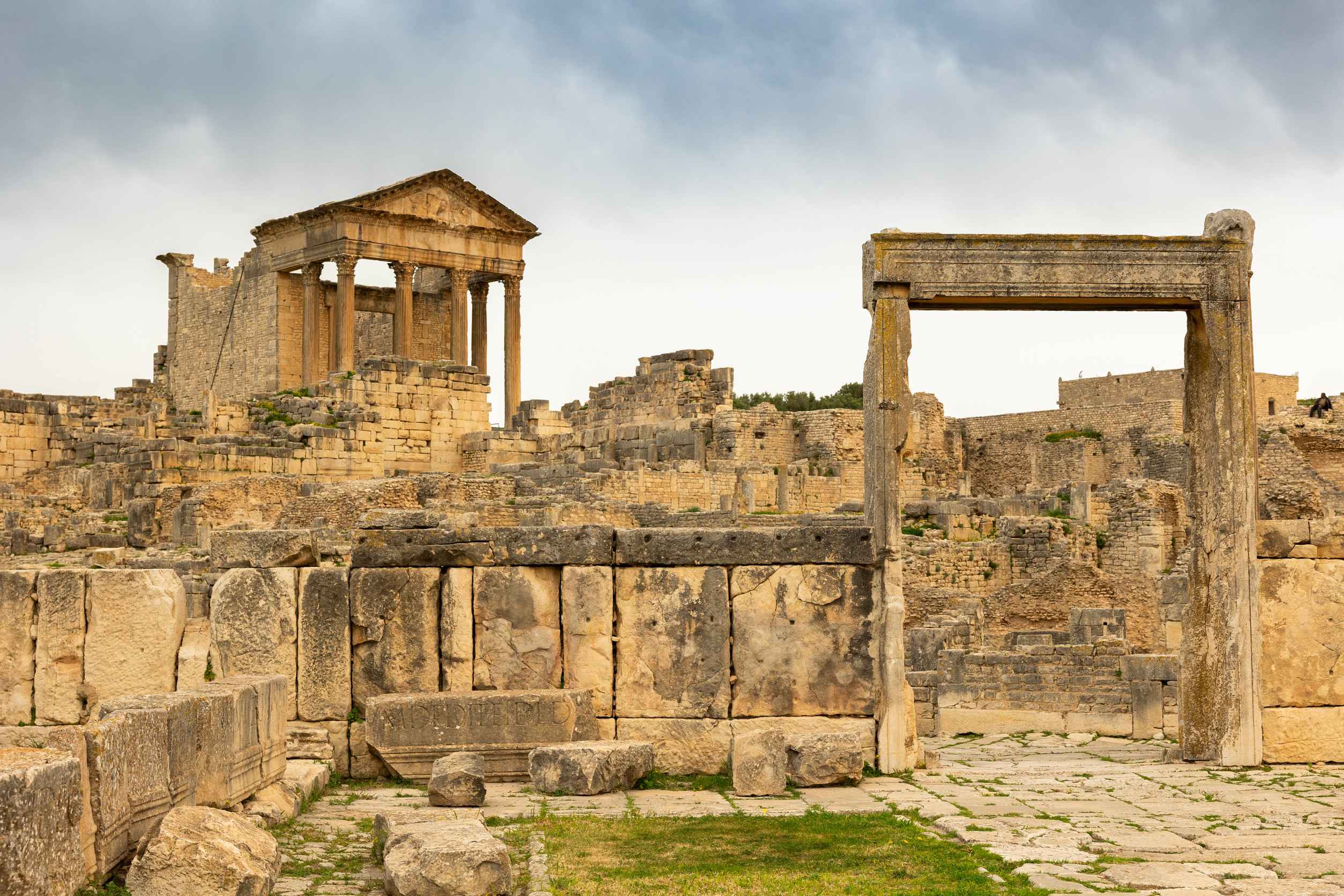
An impressive archaeological site featuring well-preserved Roman ruins, including a theatre, temples, and baths. Dougga is an ancient Roman city located in northern Tunisia, known for its remarkably well-preserved archaeological site. Here is some information about Dougga:
History: Dougga, also known as Thugga, was founded in the 6th century BCE by the Numidians and later became a prominent Roman city. It flourished during the 2nd and 3rd centuries CE and served as an important administrative and cultural center. Dougga was eventually abandoned in the 7th century, but its ruins have stood the test of time and provide valuable insights into Roman civilization.
Archaeological Site: The Dougga archaeological site is a UNESCO World Heritage site and one of the best-preserved Roman cities in North Africa. It covers a vast area and contains a wealth of well-preserved structures, including a Roman theater, temples, public baths, a marketplace, and residential buildings. The most iconic landmark of Dougga is the Capitol, a magnificent temple dedicated to the Roman gods Jupiter, Juno, and Minerva. Exploring the site allows visitors to step back in time and witness the grandeur of ancient Roman architecture and urban planning.
Culture: Dougga showcases the blending of Roman and indigenous Numidian cultures. The site contains not only Roman structures but also remnants of Numidian settlements, such as circular mausoleums and rock-cut tombs. This fusion of cultures adds to the unique character of Dougga and highlights the cultural diversity of the region.
Scenic Setting: In addition to its historical significance, Dougga is surrounded by beautiful natural landscapes. The site is perched on a hilltop, providing panoramic views of the surrounding countryside. The picturesque backdrop enhances the overall experience and offers visitors a chance to appreciate the stunning beauty of the region.
Visiting Tips: It is recommended to wear comfortable shoes and bring sun protection as the archaeological site involves walking and can be exposed to sunlight. Guided tours are available and provide valuable insights into the history and significance of the site. Dougga is located approximately 110 kilometres (68 miles) southwest of Tunis, making it a possible day trip from the capital.
Dougga is a treasure trove of Roman history and a testament to the architectural brilliance of ancient civilizations. Its well-preserved ruins and scenic surroundings make it a captivating destination for history enthusiasts and those seeking to immerse themselves in Tunisia's rich cultural heritage.
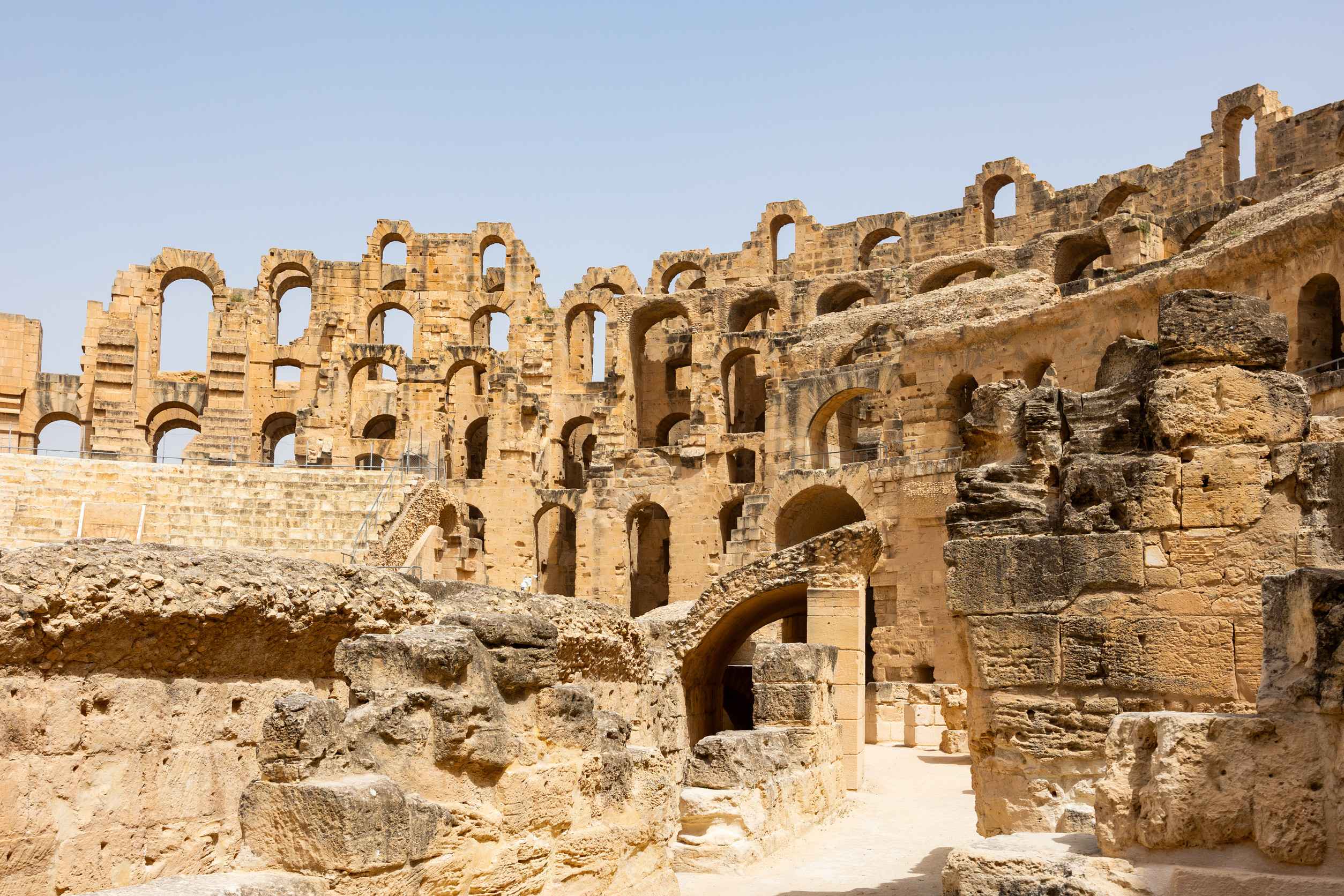
Home to one of the best-preserved Roman amphitheatres in the world, which is larger than the Colosseum in Rome. El Djem, also known as Thysdrus, is an ancient Roman city located in central Tunisia. It is most famous for its incredibly well-preserved Roman amphitheatre, which is one of the largest in the world. Here is some information about El Djem:
History: El Djem was established as a Roman colony in the 2nd century CE and became an important centre of trade and commerce. The city thrived during the 3rd century CE and served as an important regional hub. El Djem's most notable feature, the amphitheatre, was constructed around the same time and could accommodate up to 35,000 spectators.
Amphitheatre: The Roman amphitheatre of El Djem is the highlight of the city. It is considered one of the best-preserved Roman amphitheatres in the world and is a UNESCO World Heritage site. The amphitheatre's grandeur and sheer size are awe-inspiring, with its towering walls and well-preserved seating areas. Visitors can explore the various levels of the amphitheatre, including the underground chambers where gladiators and wild animals were held before their battles. The amphitheatre also hosts occasional events and performances, bringing its ancient history to life.
Archaeological Site: In addition to the amphitheatre, the archaeological site of El Djem includes other remains of the ancient city, such as the ruins of a Roman market, a fortress, and a few residential structures. The site offers visitors a chance to step back in time and imagine the daily life of the city's inhabitants during the Roman era.
Mosaic Museum: Located near the amphitheatre, the El Djem Mosaic Museum houses an impressive collection of ancient mosaics. These intricately designed mosaics depict scenes from Roman mythology, daily life, and various cultural motifs. The museum provides valuable insights into the artistic and cultural achievements of the Roman era.
Visiting Tips: El Djem is easily accessible from major cities like Tunis and Sousse. It is advisable to allocate a few hours to explore the archaeological site and fully appreciate the grandeur of the amphitheatre. Guided tours are available and provide informative explanations about the history and significance of the site.
El Djem's Roman amphitheatre is a testament to the architectural prowess and cultural richness of the Roman Empire. Its well-preserved remains offer a fascinating glimpse into the past and make it a must-visit destination for history enthusiasts and anyone interested in ancient civilizations.
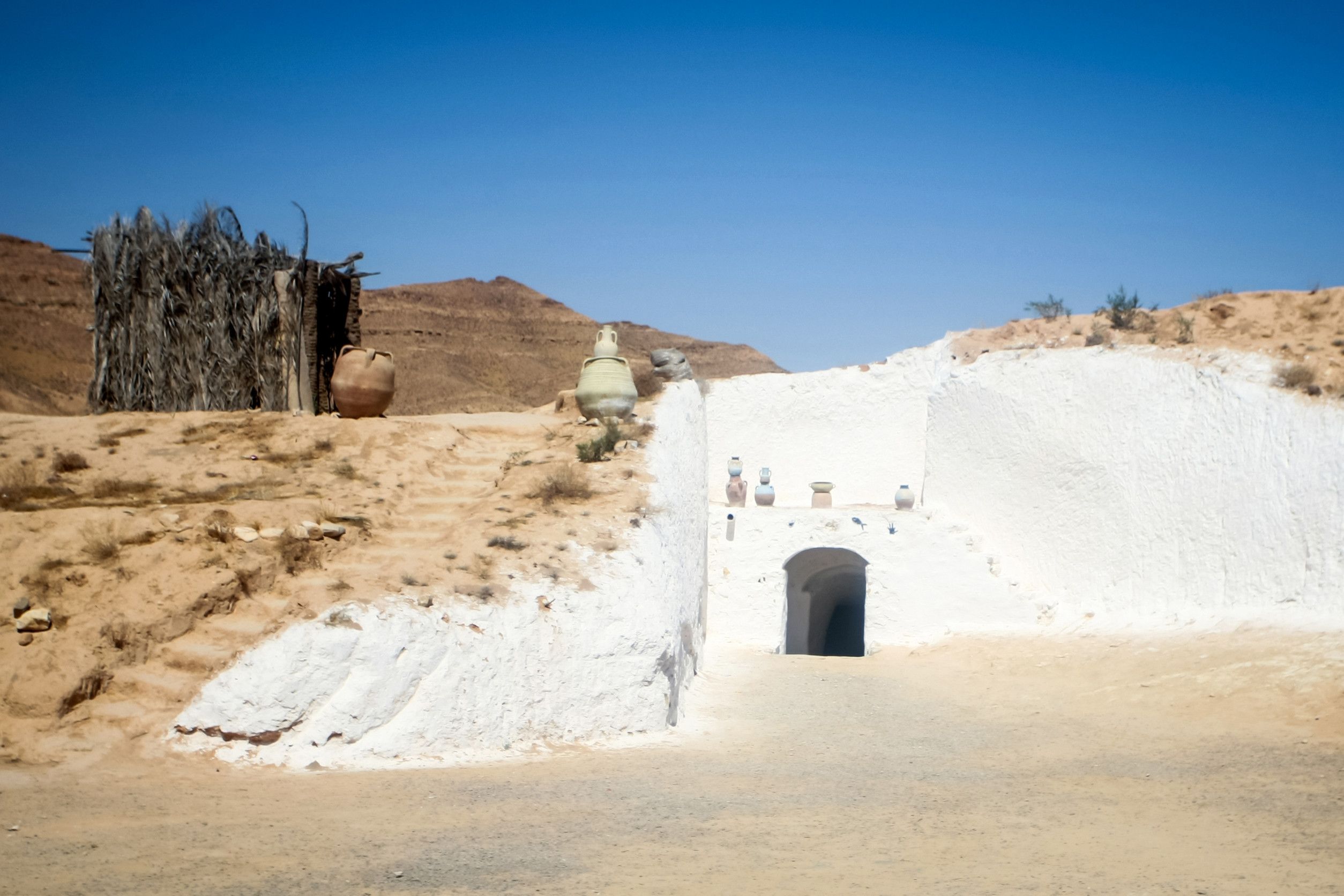
Famous for its unique underground troglodyte dwellings, which have been used as homes for centuries. Matmata is a unique and fascinating destination located in southern Tunisia. Here is some information about Matmata:
Geography and Climate: Matmata is situated in a semi-arid region known as the Dahar Mountains. The landscape is characterised by rocky hills, deep valleys, and desert-like surroundings. The climate in Matmata is generally hot and dry, with high temperatures during summer months.
History: Matmata is famous for its distinctive underground dwellings, known as troglodyte houses. These houses were originally created by the Berber people as a way to protect themselves from extreme weather conditions and invaders. The houses are carved into the soft rock formations, creating unique cave-like structures.
Culture and Traditions: Matmata is predominantly inhabited by the Berber community, known as the Matmati tribe. The Berber people have a rich cultural heritage, with unique traditions, crafts, and cuisine. Visitors to Matmata can experience the traditional way of life and learn about the customs and traditions of the local community.
Attractions: The main attraction in Matmata is the troglodyte dwellings. These underground houses provide an interesting glimpse into the traditional way of life in the region. Visitors can explore the interior of the houses, see the simple furniture and decorations, and learn about the construction techniques used by the Berber people.
Star Wars Connection: Matmata gained international fame as one of the filming locations for the Star Wars movie franchise. The unique landscape and cave-like dwellings of Matmata were used as the setting for Luke Skywalker's home in the original Star Wars film. Fans of the movies can visit the site and see the iconic locations.
Local Crafts and Souvenirs: Matmata is known for its traditional crafts, including handmade carpets, pottery, and woven baskets. Visitors can purchase these unique handicrafts as souvenirs and support the local artisans.
Visiting Tips: Matmata is located about 40 kilometres from Gabes and can be reached by car or organised tours. It is recommended to visit with a local guide who can provide insights into the history and culture of the area. Wear comfortable shoes for exploring the underground houses, as some areas may require walking on uneven surfaces.
Matmata offers a distinctive cultural and historical experience, allowing visitors to step back in time and explore the traditional way of life in an extraordinary underground setting. It is a must-visit destination for those interested in Berber culture, unique architecture, and the Star Wars connection.
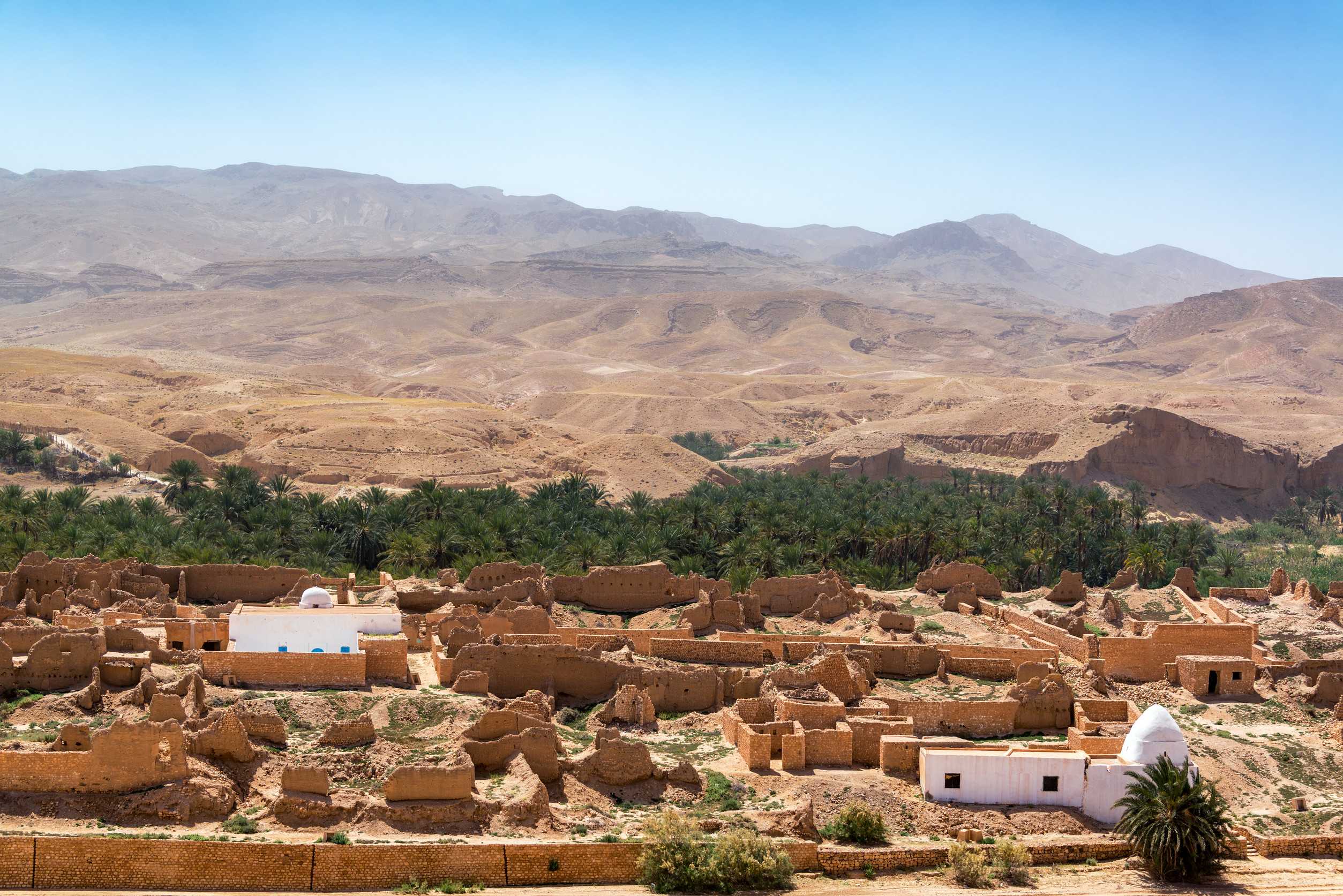
Located in the Sahara Desert, this city offers a chance to explore stunning desert landscapes, including the nearby salt lakes and oasis. Tozeur is a captivating destination located in southwestern Tunisia, known for its stunning desert landscapes, historical sites, and cultural heritage. Here is some information about Tozeur:
Geography and Climate: Tozeur is situated in the Tozeur Governorate, close to the vast Sahara Desert. The region features a desert climate with extremely hot summers and mild winters. The landscape is characterised by vast palm groves, sand dunes, and desert plains.
History: Tozeur has a rich historical background dating back to ancient times. The city was an important trading post along the ancient caravan routes, connecting sub-Saharan Africa with the Mediterranean. It has been influenced by various civilizations, including the Phoenicians, Romans, Arabs, and Ottomans.
Culture and Traditions: Tozeur is home to the indigenous Berber people, who have preserved their unique cultural traditions and customs. Visitors can experience traditional music, dance, and cuisine, as well as explore local markets selling handicrafts, spices, and dates.
Attractions: Tozeur offers several attractions that showcase its historical and natural beauty. The medina (old town) of Tozeur is a maze of narrow streets lined with traditional houses and shops. The Dar Cherait Museum is worth a visit, exhibiting artefacts and showcasing the traditional way of life in the region. The nearby oasis of Nefta is famous for its palm groves, ancient mosques, and natural springs.
Chott el Djerid: Just outside Tozeur lies Chott el Djerid, the largest salt lake in the Sahara Desert. The expansive salt flats provide a surreal and mesmerising landscape, especially during sunset and sunrise. Visitors can explore the area and enjoy the breathtaking views.
Film Locations: Tozeur has served as a filming location for several movies, including the Star Wars franchise. The nearby desert areas, such as Ong Jemel (also known as Mos Espa), have been featured in Star Wars Episode I: The Phantom Menace. Fans of the movies can visit these iconic sites and experience the cinematic charm.
Tozeur Palm Groves: The palm groves of Tozeur are a sight to behold, with thousands of date palms stretching across the landscape. Visitors can take a leisurely stroll or even a traditional horse-drawn carriage ride through the groves, appreciating the tranquillity and beauty of the surroundings.
Visiting Tips: Tozeur is well-connected by air, with flights from Tunis and other major cities in Tunisia. It is recommended to visit during the cooler months, as summers can be extremely hot. Hiring a local guide is advisable to explore the attractions and learn about the local culture and history.
Tozeur offers a unique blend of natural beauty, cultural heritage, and historical significance. From exploring ancient medinas to wandering through palm groves and experiencing the Sahara Desert, visitors to Tozeur are in for an unforgettable adventure.

An island known for its beautiful beaches, traditional architecture, and rich cultural heritage, including a historic Jewish community. Djerba is a beautiful island located off the coast of Tunisia in the Mediterranean Sea. It is known for its pristine beaches, rich history, vibrant culture, and unique architecture.
Here is some information about Djerba:
Geography and Climate: Djerba is the largest island in North Africa and is connected to mainland Tunisia by a causeway. The island enjoys a Mediterranean climate, with hot summers and mild winters. Djerba is characterised by its sandy beaches, palm groves, and picturesque landscapes.
History: Djerba has a long and diverse history that dates back thousands of years. It has been inhabited by various civilizations, including the Phoenicians, Romans, Byzantines, Arabs, and Ottomans. The island has served as an important trading hub and has witnessed the influences of different cultures over the centuries.
Culture and Traditions: Djerba is home to a vibrant cultural heritage, shaped by its mix of Berber, Arab, and Jewish influences. The island is known for its traditional crafts, such as pottery, carpet weaving, and silverwork. Visitors can explore local markets and engage with the friendly locals, experiencing the warmth and hospitality for which Djerba is known.
Attractions: Djerba offers a range of attractions for visitors to explore. The main town on the island is Houmt Souk, where you can wander through its narrow streets, visit local shops and markets, and discover the traditional architecture and vibrant atmosphere. The Djerba Explore Park is a popular tourist spot, featuring a crocodile farm, a traditional village, and a museum showcasing the history and culture of the island. The El Ghriba Synagogue, located in the village of Hara Sghira, is one of the oldest synagogues in the world and is a significant religious site for the Jewish community.
Beaches: Djerba is renowned for its stunning beaches with crystal-clear waters and soft golden sands. Visitors can relax, swim, sunbathe, and enjoy various water sports and activities. Some of the popular beaches on the island include Sidi Mahrez, Seguia, and Ras Rmel.
Ghriba Pilgrimage: The El Ghriba Synagogue attracts thousands of visitors each year, particularly during the annual Ghriba Pilgrimage, which takes place around May. This religious pilgrimage is a significant event for the Jewish community and attracts visitors from all over the world.
Watersports and Outdoor Activities: Djerba offers a range of watersports and outdoor activities for adventure enthusiasts. Visitors can enjoy activities such as windsurfing, kitesurfing, sailing, snorkelling, and scuba diving in the crystal-clear waters surrounding the island.
Visiting Tips: Djerba has an international airport, making it easily accessible for travellers. It is advisable to visit during the spring or autumn months when the weather is pleasant and crowds are fewer. Exploring the island by renting a car or hiring a local guide is recommended to fully appreciate its attractions and hidden gems.
Djerba's combination of natural beauty, cultural heritage, and warm hospitality make it a must-visit destination in Tunisia. Whether you're seeking relaxation on the beaches, delving into history and culture, or enjoying outdoor adventures, Djerba has something to offer every traveller.
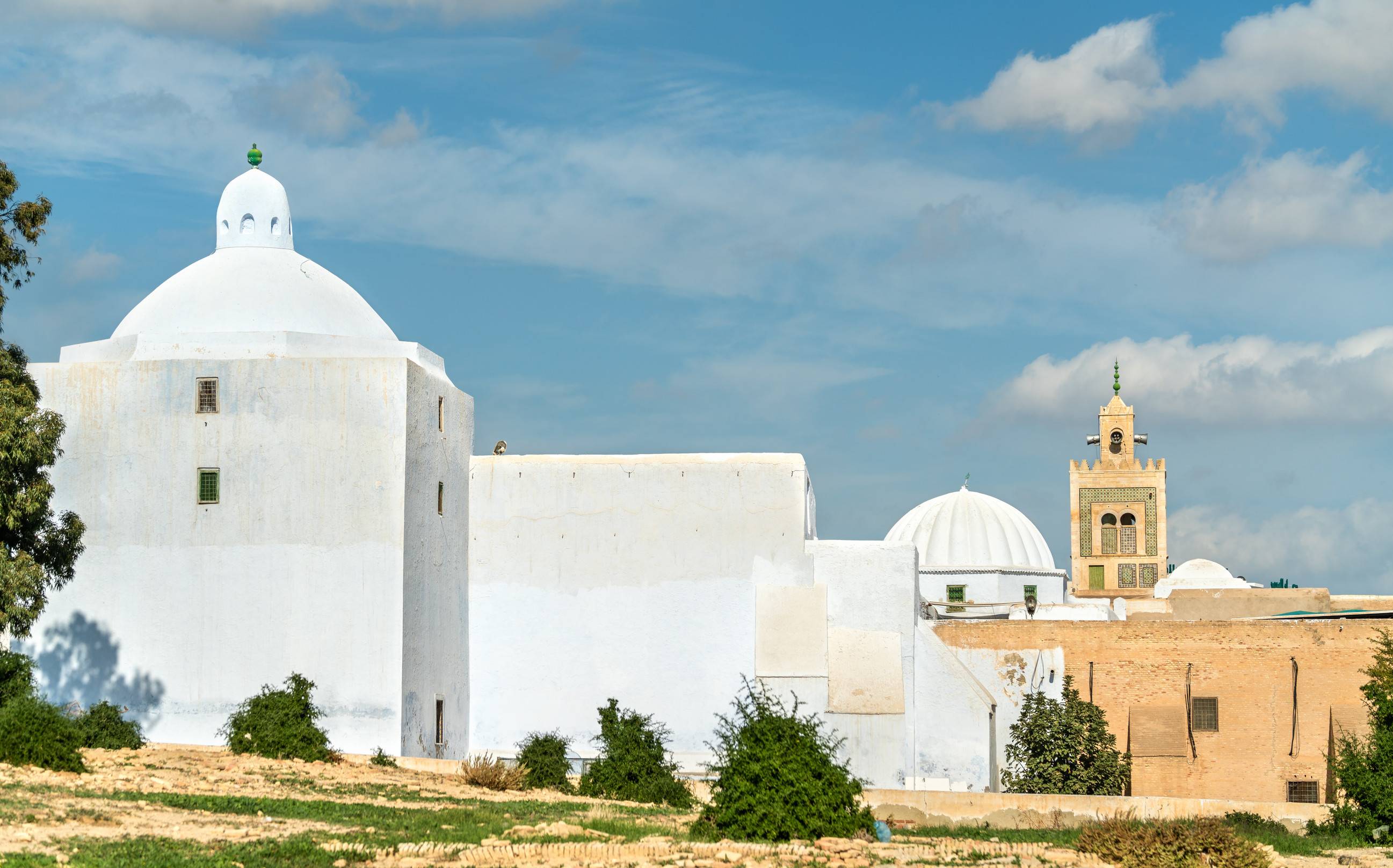
Considered the fourth holiest city in Islam, it features the Great Mosque of Kairouan, one of the oldest and most significant mosques in the world. Kairouan is a city located in central Tunisia and is considered one of the country's holiest Islamic sites. It has a rich history, cultural significance, and architectural marvels. Here is some information about Kairouan:
History: Kairouan was founded in the 7th century AD and quickly became an important centre of Islamic learning and spirituality. It played a significant role in the spread of Islam throughout North Africa. The city was a hub of intellectual and cultural activity, attracting scholars, theologians, and students from all over the Muslim world.
Great Mosque of Kairouan: The Great Mosque of Kairouan, also known as the Mosque of Uqba, is the centrepiece of the city and one of the oldest and most important mosques in the Islamic world. It was built in the 7th century and has undergone several expansions and renovations over the centuries. The mosque features stunning architectural details, including intricate tilework, carved woodwork, and beautiful courtyards. It is a UNESCO World Heritage Site and a major pilgrimage site for Muslims.
Medina of Kairouan: The old town of Kairouan, known as the Medina, is a maze of narrow streets, historic buildings, and bustling markets. It offers a glimpse into the city's past and is a great place to explore on foot. Visitors can wander through the winding streets, visit traditional shops, admire the traditional architecture, and experience the lively atmosphere of the Medina.
Aghlabid Basins: The Aghlabid Basins, also known as the Water Reservoirs of Kairouan, are a series of large cisterns that were built in the 9th century to provide the city with water. The basins are an impressive feat of engineering and an important historical site. They are located just outside the old town and offer a tranquil and scenic spot for visitors to explore.
Museums: Kairouan is home to several museums that showcase the city's history and culture. The Museum of Islamic Art displays a collection of Islamic art and artefacts, including ceramics, textiles, and manuscripts. The Museum of Popular Traditions offers insight into the local traditions and crafts of the region.
Carpet Weaving: Kairouan is renowned for its traditional carpet weaving industry. Visitors can visit local workshops and see skilled artisans creating intricate carpets and rugs using traditional techniques. It is also possible to purchase handmade carpets as souvenirs.
Visiting Tips: Kairouan is located approximately 150 kilometres south of Tunis, the capital city of Tunisia. The city can be reached by car or public transportation. It is advisable to dress modestly when visiting religious sites and to respect local customs and traditions. Hiring a local guide is recommended to gain a deeper understanding of the city's history and significance.
Kairouan offers a unique blend of history, spirituality, and cultural heritage. Whether you are fascinated by Islamic architecture, interested in exploring ancient Medina streets, or keen to experience traditional crafts, Kairouan provides a memorable journey into Tunisia's rich past and religious traditions.
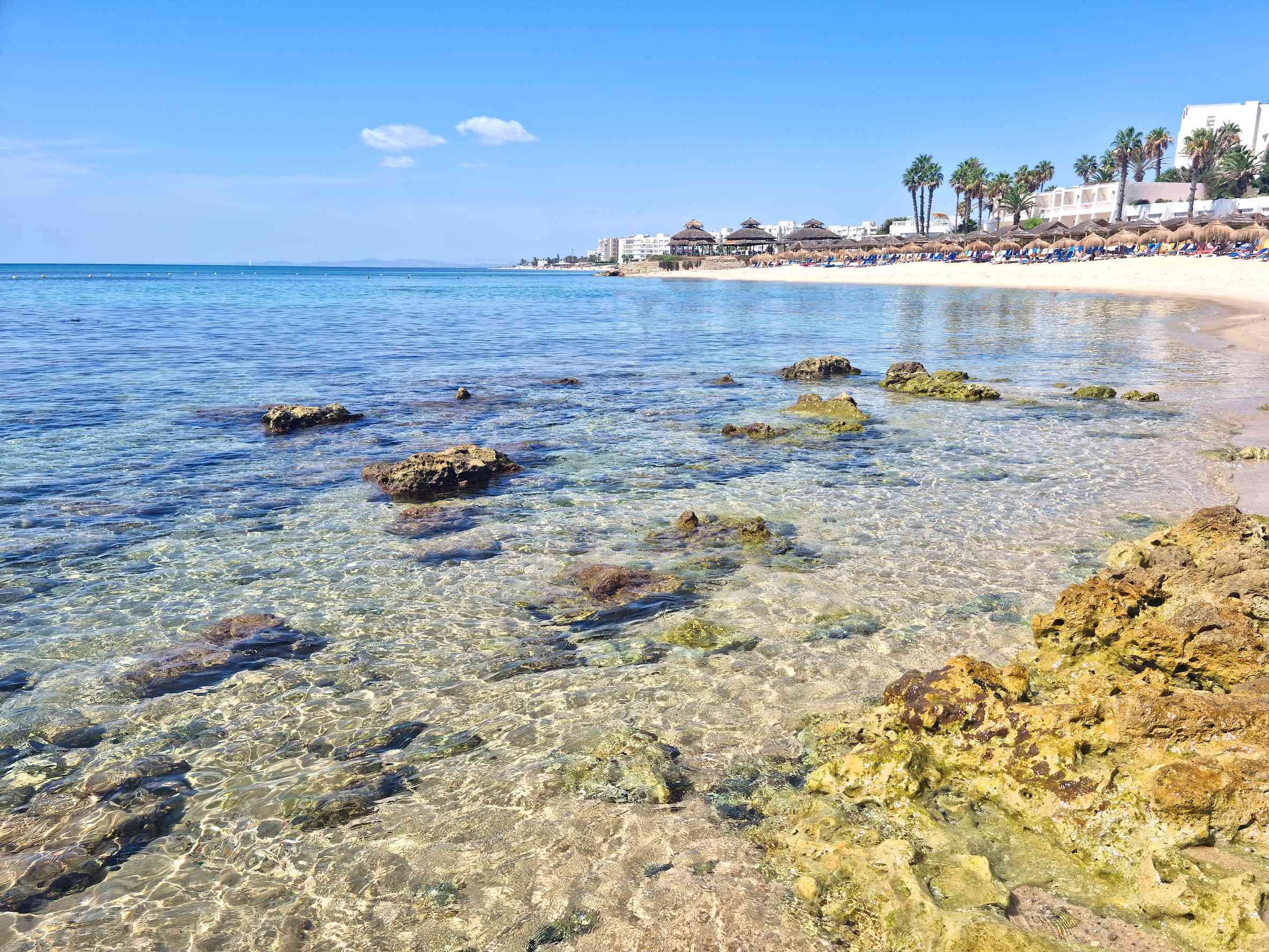
A popular coastal resort town known for its sandy beaches, luxurious hotels, and vibrant nightlife. Hammamet is a popular coastal resort town located in northeastern Tunisia, known for its beautiful sandy beaches, historic sites, and vibrant atmosphere. Here is some information about Hammamet:
Climate: Hammamet enjoys a Mediterranean climate with hot, dry summers and mild, wet winters. Summers are usually warm and sunny, with temperatures ranging from 25 to 35 degrees Celsius (77 to 95 degrees Fahrenheit). Winters are mild, with temperatures ranging from 10 to 18 degrees Celsius (50 to 64 degrees Fahrenheit). The best time to visit Hammamet is during the spring and autumn months when the weather is pleasant and there are fewer crowds.
History: Hammamet has a rich history dating back to ancient times. The town was founded by the Phoenicians and later became a Roman settlement. It was an important trading port and played a significant role in the region's history. Today, remnants of its past can still be seen in the form of historic sites such as the Puppet Roman Site and the ancient fortress walls.
Culture: Hammamet is known for its vibrant cultural scene. The town hosts various cultural festivals and events throughout the year, including the International Festival of Hammamet, which showcases music, theatre, and dance performances. The town is also home to several art galleries and museums, where visitors can explore Tunisian art and heritage.
Beaches: Hammamet is famous for its pristine sandy beaches and crystal-clear waters. The main beach, Hammamet Beach, stretches along the coastline and offers various water sports activities such as swimming, snorkelling, and jet skiing. The beach is lined with resorts, restaurants, and beach clubs, providing a relaxing and enjoyable beach experience.
Medina of Hammamet: The Medina of Hammamet is the historic heart of the town. It is a walled city with narrow, winding streets filled with shops, cafes, and traditional houses. Inside the Medina, visitors can explore the bustling souks (markets), where they can find local crafts, ceramics, textiles, and souvenirs.
Carthage Land: Carthage Land is an amusement park located in Hammamet, offering a range of rides, attractions, and entertainment for the whole family. The park features roller coasters, water slides, shows, and various games, making it a popular destination for both locals and tourists.
Visiting Tips: Hammamet is located approximately 60 kilometres (37 miles) southeast of Tunis and can be easily reached by car or public transportation. The town is well-equipped with hotels, resorts, and restaurants, offering a range of accommodations and dining options. It is advisable to dress modestly when visiting religious sites and to respect local customs and traditions.
Hammamet is a delightful destination that combines history, culture, beautiful beaches, and modern amenities. Whether you're seeking relaxation on the sandy shores, exploring ancient ruins, or immersing yourself in the local culture, Hammamet has something to offer for every traveller.
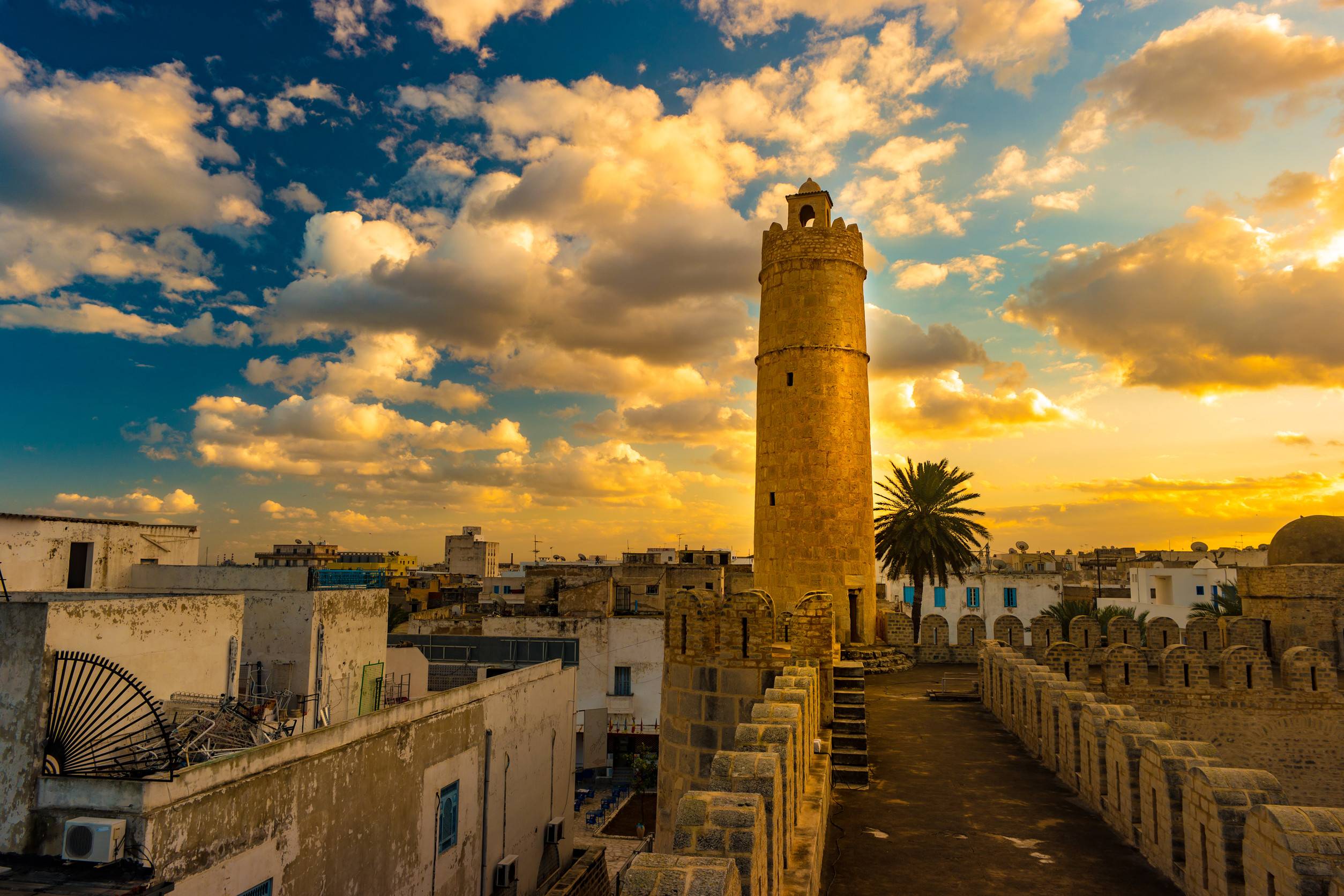
Home to a charming medina, a UNESCO World Heritage Site, and beautiful beaches along the Mediterranean coast. Sousse is a vibrant coastal city located in eastern Tunisia, known for its sandy beaches, rich history, and lively atmosphere. Here is some information about Sousse:
Climate: Sousse enjoys a Mediterranean climate with hot, dry summers and mild, wet winters. Summers are typically hot and sunny, with temperatures ranging from 25 to 35 degrees Celsius (77 to 95 degrees Fahrenheit). Winters are mild, with temperatures ranging from 10 to 18 degrees Celsius (50 to 64 degrees Fahrenheit). The best time to visit Sousse is during the spring and autumn months when the weather is pleasant and there are fewer crowds.
History: Sousse has a fascinating history dating back to ancient times. It was founded by the Phoenicians and later became an important Roman settlement. The city flourished during the Islamic period and was a significant centre of trade and culture. Today, Sousse is recognized as a UNESCO World Heritage site for its well-preserved Medina and historic landmarks.
Medina of Sousse: The Medina of Sousse is the heart of the city and one of the best-preserved mediaeval medinas in Tunisia. It is a UNESCO World Heritage site and a fascinating place to explore. Inside the Medina, visitors can wander through narrow alleys, admire traditional architecture, and discover local shops, cafes, and historic sites such as the Great Mosque and Ribat fortress.
Beaches: Sousse is renowned for its beautiful sandy beaches along the Mediterranean coast. The main beach, Boujaafar Beach, stretches for several kilometres and offers clear turquoise waters and soft golden sand. Visitors can relax on the beach, swim, sunbathe, or engage in water sports activities such as snorkelling and jet skiing.
Archaeological Museum of Sousse: Located in the Medina, the Archaeological Museum of Sousse is a must-visit for history enthusiasts. The museum houses a remarkable collection of artefacts from various periods, including Roman mosaics, sculptures, ceramics, and jewellery, providing insights into the city's rich past.
Port El Kantaoui: Just a short distance from Sousse, Port El Kantaoui is a modern marina and resort complex. It features a picturesque harbour with luxury yachts, a vibrant promenade lined with shops, restaurants, and cafes, and a wide range of recreational activities such as golf, water sports, and horseback riding.
Ribat of Sousse: The Ribat of Sousse is a fortified structure that served as a defensive stronghold during ancient times. It offers panoramic views of the city and the Mediterranean Sea. Visitors can climb to the top of the tower for a stunning vista and explore the interior of the fortress.
Visiting Tips: Sousse is located approximately 140 kilometres (87 miles) southeast of Tunis and can be reached by car or public transportation. The city offers a variety of accommodations, ranging from luxury resorts to budget-friendly hotels. It is advisable to dress modestly when visiting religious sites and to respect local customs and traditions.
Sousse combines history, beachside relaxation, and modern amenities, making it a popular destination for travellers. Whether you're interested in exploring ancient ruins, soaking up the sun on the beach, or immersing yourself in the vibrant local culture, Sousse has something for everyone.

Known for its unique Berber architecture and as the filming location for some scenes in the Star Wars movies. Tataouine is a city located in southern Tunisia, known for its unique architecture, desert landscapes, and cultural heritage. Here is some information about Tataouine:
Climate: Tataouine experiences a hot desert climate. Summers are extremely hot, with temperatures often exceeding 40 degrees Celsius (104 degrees Fahrenheit). Winters are mild, with temperatures ranging from 10 to 20 degrees Celsius (50 to 68 degrees Fahrenheit). The region receives very little rainfall throughout the year.
History and Culture: Tataouine is named after the Berber tribe "Tataouine," which inhabited the area. The city has a rich history, and its architecture reflects a mix of Berber, Arab, and French influences. Tataouine is famous for its ksour (fortified granaries) and troglodyte dwellings, which are traditional underground houses carved into the rock. These unique structures have been featured in movies such as "Star Wars," adding to the city's appeal.
Ksour: The region surrounding Tataouine is dotted with ksour, which are traditional fortified granaries. These structures were used to store grains and served as defensive settlements for the local population. The ksour of Tataouine are characterised by their distinctive architecture, with mud-brick walls, narrow streets, and rooftop terraces offering panoramic views of the surrounding desert.
Troglodyte Dwellings: The troglodyte dwellings in Tataouine are a highlight for visitors. These underground houses were traditionally used by the Berber people to escape the heat of the desert. Today, some of these dwellings have been converted into accommodations, allowing visitors to experience the unique lifestyle and architecture of the region.
Chenini: Chenini is a nearby village known for its troglodyte dwellings and ancient mosque. It offers an authentic experience of Berber culture and architecture. Visitors can explore the narrow streets, visit local craft shops, and climb up to the hilltop mosque for panoramic views.
Desert Excursions: Tataouine is a gateway to the Sahara Desert, and many visitors choose to take desert excursions from the city. These excursions often include camel rides, sand dune exploration, and overnight stays in desert camps. It is an opportunity to experience the vastness and beauty of the desert landscapes.
Local Cuisine: While in Tataouine, be sure to try the local cuisine, which includes traditional Berber dishes and flavours influenced by North African and Middle Eastern cuisines. Some popular dishes to try are couscous, tagine, and various grilled meats. Don't forget to enjoy a cup of mint tea, a staple in Tunisian culture.
Visiting Tips: Tataouine is located approximately 480 kilometres (298 miles) south of Tunis, and reaching the city by car or organised tour is recommended. It is advisable to bring appropriate clothing and sunscreen to protect yourself from the intense desert sun. Respect local customs and traditions, especially when visiting religious sites and interacting with the local population.
Tataouine offers a unique glimpse into Berber heritage and desert landscapes. Whether you're fascinated by the distinctive architecture, interested in exploring the desert, or curious about the local culture, Tataouine provides an authentic and memorable experience.
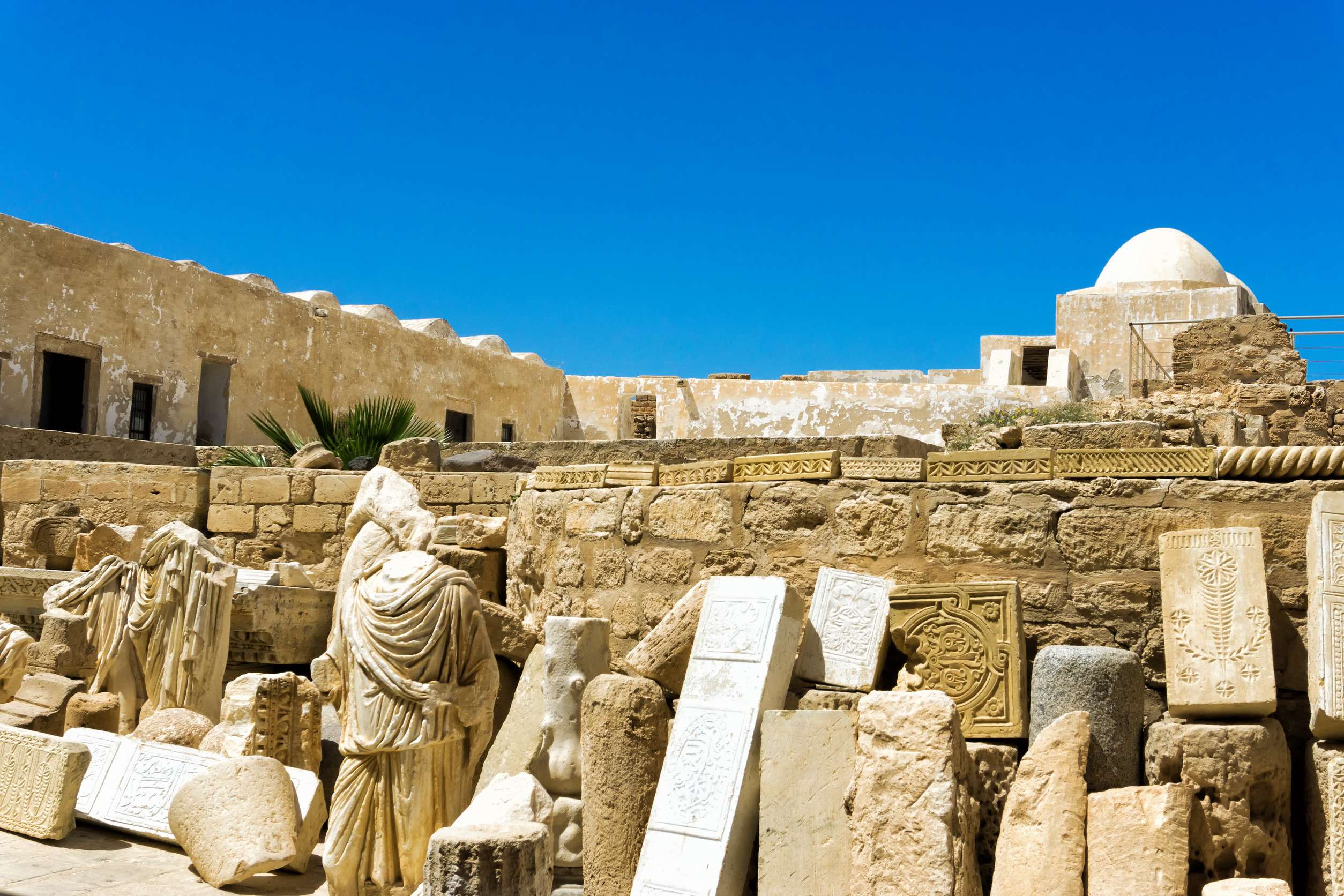
A historic coastal city with a picturesque old town, a 10th-century Fatimid port, and beautiful sandy beaches. Mahdia is a coastal city in Tunisia known for its beautiful sandy beaches, rich history, and cultural attractions. Here is some information about Mahdia:
Climate: Mahdia enjoys a Mediterranean climate with hot, dry summers and mild, rainy winters. Summers are generally hot and sunny, with temperatures reaching up to 35 degrees Celsius (95 degrees Fahrenheit). Winters are mild, with temperatures averaging around 15 degrees Celsius (59 degrees Fahrenheit). The best time to visit Mahdia is during the spring and autumn months when the weather is pleasant.
History and Culture: Mahdia has a long and fascinating history. It was founded by the Phoenicians in the 9th century BC and later became an important trading port under Roman and Byzantine rule. In the 10th century, it became the capital of the Fatimid Caliphate and flourished as a cultural and economic centre. Today, remnants of its historical past can be seen in its ancient walls, mosques, and archaeological sites.
El Jem Amphitheatre: While not located in Mahdia itself, the nearby town of El Jem is home to one of the most impressive Roman ruins in Tunisia - the El Jem Amphitheatre. This well-preserved amphitheatre, dating back to the 3rd century AD, is a UNESCO World Heritage Site and a must-visit attraction for history enthusiasts.
Mahdia Medina: The heart of Mahdia is its old town, known as the Medina. The Medina is a maze of narrow streets lined with white-washed buildings adorned with blue accents. It is a charming place to explore, with traditional markets, artisan shops, and historic landmarks such as the Great Mosque of Mahdiya.
Mahdia Beaches: Mahdia is renowned for its beautiful sandy beaches that stretch along the Mediterranean coastline. The beaches offer crystal-clear waters and a range of water activities, including swimming, sunbathing, and water sports. Some popular beaches in Mahdia include Plage de Mahdia, Plage de Corniche, and Plage de la Mediterranee.
Fatimid Ship Museum: Located within the old fortress of Borj el-Kebir, the Fatimid Ship Museum showcases a preserved 9th-century shipwreck discovered off the coast of Mahdia. The museum provides insight into the region's maritime history and the trade routes of the Fatimid period.
Mahdia Fishing Port: The fishing port of Mahdia is a bustling hub of activity, especially in the early morning when fishermen bring in their catch. Visitors can witness the traditional fishing techniques, explore the fish market, and even sample fresh seafood at local restaurants.
Local Cuisine: Mahdia is known for its delicious seafood dishes, influenced by both Mediterranean and Tunisian flavours. Some popular dishes to try include grilled fish, seafood couscous, and spicy seafood stew. The city also offers a variety of traditional Tunisian dishes, such as couscous, tagine, and brik.
Visiting Tips: Mahdia can be easily reached by road or train from Tunis or Sousse. It is recommended to wear comfortable clothing and sunscreen, especially during the hot summer months. Remember to respect local customs and dress modestly when visiting religious sites. It's also a good idea to explore the city on foot to fully immerse yourself in its charm and discover hidden gems within the Medina.
Mahdia offers a perfect blend of history, culture, and stunning coastal landscapes. Whether you're interested in exploring historical sites, relaxing on beautiful beaches, or indulging in local cuisine, Mahdia has something to offer for every traveller.

Located at the mouth of the Medjerda River, it offers opportunities for boat trips, exploring palm groves, and visiting the nearby Roman ruins of Gightis. Gabes is a city in southern Tunisia, located on the Mediterranean coast. Here is some information about Gabes:
Climate: Gabes experiences a Mediterranean climate with hot and dry summers and mild winters. Summers can be quite hot, with temperatures reaching up to 40 degrees Celsius (104 degrees Fahrenheit), while winters are relatively mild with temperatures ranging between 10 to 20 degrees Celsius (50 to 68 degrees Fahrenheit). The best time to visit Gabes is during the spring or autumn when the weather is pleasant.
History and Culture: Gabes has a rich history that dates back to ancient times. The city was an important centre for the Phoenicians, Romans, and Byzantines. It later became part of the Islamic civilization under Arab rule. Gabes has a unique cultural blend influenced by various civilizations and is known for its traditional crafts such as pottery and carpet weaving.
Gabes Oasis: The city is famous for its oasis, known as the Gabes Oasis. This vast palm grove stretches along the coast and provides a lush and green landscape in contrast to the surrounding desert. Visitors can explore the oasis, take a stroll among the palm trees, and discover traditional irrigation systems used by local farmers.
Gabes Medina: The old town of Gabes, also known as the Medina, is a charming place to explore. It features narrow winding streets, traditional houses, and local markets where you can find spices, handicrafts, and local products. The Medina offers a glimpse into the traditional way of life in Gabes.
Qal'at al-Bunayat: Perched on a hill overlooking the city, Qal'at al-Bunayat is an ancient fortress that dates back to the Byzantine period. The fortress provides panoramic views of the city and the surrounding landscape. It is an interesting historical site to visit and offers insight into the region's past.
Gabes Beaches: Gabes is known for its beautiful beaches along the Mediterranean coast. The beaches offer golden sands and clear blue waters, providing opportunities for swimming, sunbathing, and water sports. Some popular beaches in Gabes include Plage de Sidi Bouzid and Plage de Menzel Habib.
Local Cuisine: Gabes is renowned for its delicious cuisine, which reflects the flavours of Tunisian and Mediterranean dishes. Local specialties include couscous, tagines, seafood dishes, and a variety of vegetarian options. Visitors can explore local restaurants and cafes to savour the authentic flavours of Gabes.
Visiting Tips: To reach Gabes, you can take a domestic flight to Gabes-Matmata International Airport or travel by train or bus from other cities in Tunisia. It is advisable to carry sunscreen, a hat, and comfortable clothing, especially during the summer months. When visiting religious sites or the Medina, it is recommended to dress modestly out of respect for local customs.
Gabes offers a mix of natural beauty, cultural heritage, and a relaxing coastal atmosphere. Whether you're interested in exploring historical sites, enjoying the palm groves, or unwinding on the beaches, Gabes has something to offer for every traveller.
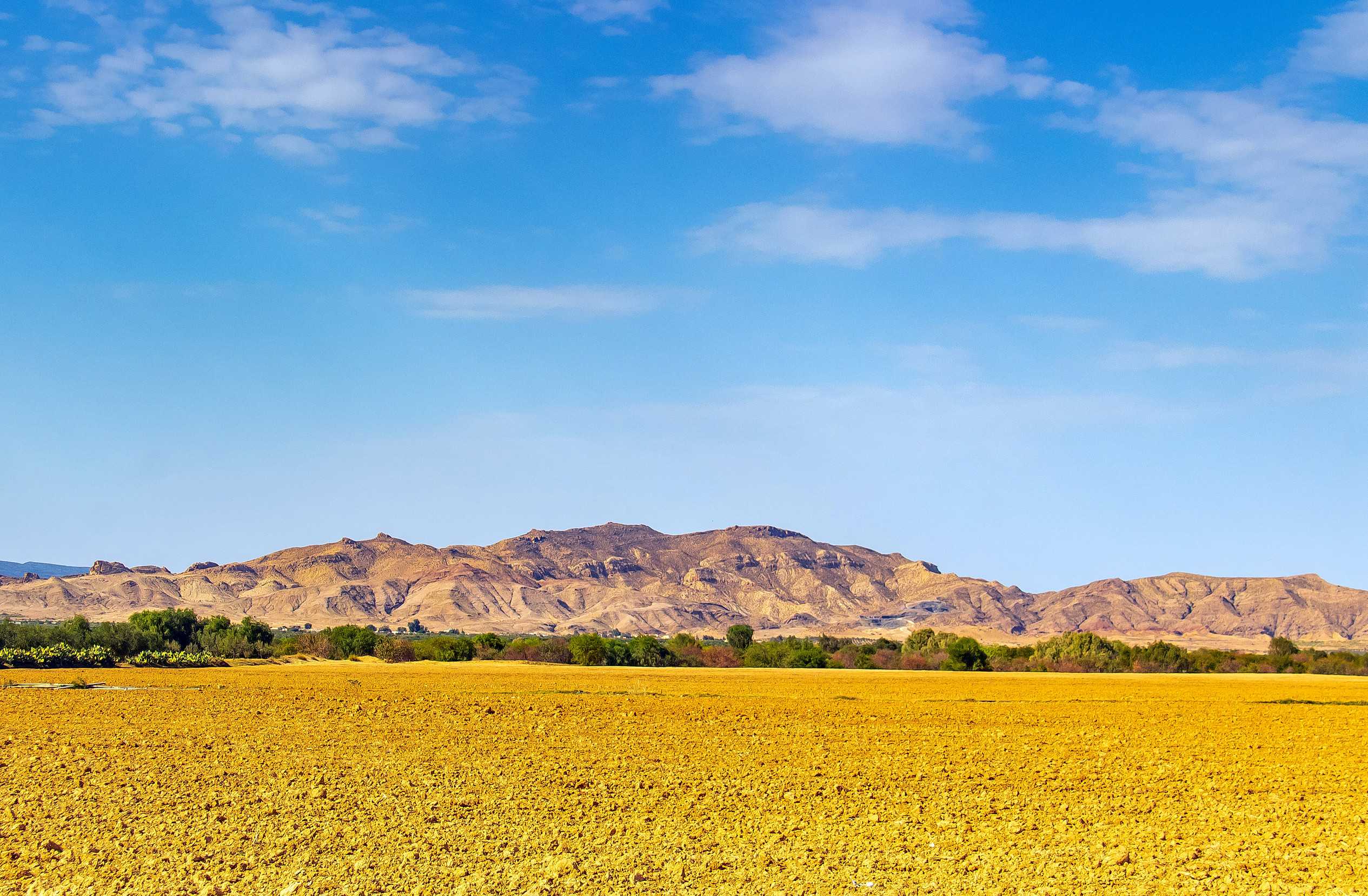
A gateway to the stunning landscapes of the Sahara Desert, including the dramatic canyons of Sidi Bouhlel and the lush waterfall-filled oasis of Tamerza. Gafsa is a city located in southwestern Tunisia. Here is some information about Gafsa:
Climate: Gafsa experiences a hot desert climate characterised by extremely hot summers and mild winters. Summers can be scorching, with temperatures reaching well above 40 degrees Celsius (104 degrees Fahrenheit), while winters are relatively mild with temperatures ranging between 10 to 20 degrees Celsius (50 to 68 degrees Fahrenheit). The city receives very little rainfall throughout the year.
History and Culture: Gafsa has a rich history dating back to ancient times. The region was inhabited by Berber tribes and later became part of the Roman Empire. It played a significant role as an agricultural centre during the Roman era and was known for its production of olive oil. Gafsa has a diverse cultural heritage influenced by its Berber, Roman, and Islamic history.
Gafsa Oasis: The city is renowned for its oasis, known as the Gafsa Oasis or the Oasis of Gafsa. The oasis stretches over a vast area and is characterised by lush palm groves, citrus orchards, and agricultural fields. Visitors can explore the oasis, take a leisurely walk among the palm trees, and enjoy the serene and green surroundings.
Roman Ruins of Gafsa: Gafsa is home to several Roman ruins that provide insights into its ancient history. The most notable site is the Roman Baths of Gafsa, which are well-preserved and feature impressive architectural elements. The ruins showcase the advanced engineering and construction techniques of the Roman civilization.
Mountains and Natural Landscapes: Gafsa is located near the Atlas Mountains, offering opportunities for hiking and exploring nature. The region is known for its scenic landscapes, including Jebel Orbata, a mountain range with stunning views and hiking trails. The Chott el Djerid, a large salt lake located nearby, is also a notable natural attraction.
Traditional Crafts: Gafsa is known for its traditional crafts, including pottery and carpet weaving. Visitors can witness the intricate craftsmanship of local artisans and even purchase handmade souvenirs.
Local Cuisine: Gafsa offers a variety of delicious Tunisian dishes influenced by local ingredients and traditional cooking methods. Some popular local dishes include couscous, tajine, grilled meats, and savoury pastries. Visitors can explore local restaurants and cafes to savour the flavours of Gafsa's cuisine.
Visiting Tips: Gafsa can be reached by taking a domestic flight to Gafsa-Ksar International Airport or by road transportation from other cities in Tunisia. It is advisable to carry sunscreen, a hat, and comfortable clothing, especially during the hot summer months. Gafsa is a relatively lesser-known tourist destination, so it's recommended to have a basic understanding of Arabic or French for ease of communication.
Gafsa offers a unique blend of historical significance, natural beauty, and traditional culture. Whether you're interested in exploring ancient ruins, experiencing the oasis lifestyle, or immersing yourself in the local cuisine, Gafsa provides a glimpse into the rich heritage of southwestern Tunisia.
These are just a few of the many incredible destinations in Tunisia, each offering its own unique blend of history, culture, natural beauty, and warm hospitality.

To help us improve